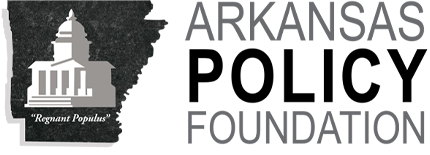“Reduce the state’s income tax…repeal the state’s capital gains tax.” Arkansas Policy Foundation, Murphy Commission project, 1998
(November 2012) The policy climate has shifted dramatically in Arkansas, with Republicans winning control of the state Senate, 21-14, and state House, 51-48-11, for the first time since Reconstruction. The stage is set for a serious policy debate around a question advanced by the Policy Foundation since its 1995 founding: “How to cut taxes in Arkansas?’ Fiscal policy in this new environment should focus on income, capital gains and grocery tax rates, and their potential effect on household budgets, job creation and state revenues.
Income Tax Cut: Response to Inflation
Current Arkansas fiscal policy punishes middle-class households.2 Middle-class households pay the top seven percent (7%) rate starting near $35,000,3 a threshold less than Arkansas median household income ($41,302) as reported by the federal government.4 This morally reprehensible5 policy should be a top priority of the new General Assembly when it meets in January 2013.
The inflation problem dates to the 1970s when a Democratic governor and General Assembly increased the top income tax rate from five (5%) to seven (7%) without indexing for inflation. Gov. Dale Bumpers and the legislature raised the state’s top income tax rate in 1971 but failed to adjust the measure for CPI.6 The U.S. economy in the 1970s recorded the highest average annual CPI rate (7.1%) of the 20th Century.7 Inflation,8 became such an issue that tax cuts negotiated by Republican President Ronald Reagan and a Democrat-controlled Congress in the early 1980s included a CPI adjustment. A modest adjustment occurred in Arkansas in the late 1990s, though the issue has largely been ignored.9 The magnitude of the problem is reflected in a 1996 chart from the Bureau of Legislative Research’s Office of Economic and Tax Research. It illustrates how the failure to adjust tax rates to CPI has punished Arkansas’ middle class:
Rate Income Level Level Adjusted for CPI
1.0% First $2,999 First $10,828
2.5% $3,000-$5,999 $10,833-$21,661
3.5% $6,000-$8,999 $21,664-$32,493
4.5% $9,000-$14,999 $32,497-$54,158
6.0% $15,000-$24,999 $54,161-$90,265
7.0% Over $25,000 Over $90,269
A 2008 Foundation analysis found retroactive CPI indexing of the 1971 tax hike would create a $132,607 income threshold for the 7% rate.10
There are two ways to address the problem. First, the number of brackets could be reduced, with lower rates in all. Arkansas has six individual brackets ranging from one (1.0%) to seven percent (7%), according to the Federation of State Tax Administrators in Washington, D.C. Arkansas would have one flat rate, or two, three, four or five rates with lower income thresholds and rates. Second, the number of brackets could remain the same with lower rates in all. State Rep. Charlie Collins, R-Fayetteville, advanced this idea in the last General Assembly (2011), proposing a top six-and-eight-tenths (6.8%) percent rate.11 The proposal died in committee but support for an income tax cut has emerged in recent years. The state House passed an income tax cut in 2007.12
Capital Gains Tax Cut: Response to Arkansas’ Weak Jobs Market
Nonfarm payroll employment is the broadest economic indicator at the state level. Total Arkansas payroll employment has grown an anemic 0.5 percent three years into the current national expansion. U.S. payroll employment has expanded 2.3 percent.13 The problem is long-term measured across the business cycle. Arkansas also trailed the U.S. in the previous expansion.14 The problem is greater when comparing Arkansas with states that do not tax capital gains. These states have increased employment 3.3 percent in the expansion. They also created jobs at higher percentage rates than the U.S. and Arkansas in the last two expansions.15 Two (Tennessee and Texas) border Arkansas, one reason that Gov. Huckabee and a Democrat-controlled General Assembly reduced the state capital gains rate 30 percent in 1999.16
The idea of tax reduction is dismissed by critics without due consideration.17 Yet state reports have raised the issue. The Fluor GLS18 report in 2002, commissioned by the General Assembly included a lengthy discussion of Arkansas’ competitive disadvantage with states in the region. The state Economic Development Commission’s 2006 annual report noted, “Arkansas continues to rank near the bottom in several economic indicators,” and included a proposal to reduce state capital gains rates:
Expatriate incentive: “There have been discussions about an effort to bring back to the state thousands of Arkansans who were born here, went to school here or previously lived here, such as that implemented by El Dorado’s Come Home El Dorado program. Incentives such as capital gains tax or income tax exemptions are being explored as possible inducements to repatriation.”19
There are three ways to reduce capital gains taxes. The narrowest way is to cut the tax another 30 percent.20 Arkansas investments could be exempted. Or they could be phased out over a multi-year period.21
The Compromise
Some grocery tax cut proponents22 argue fiscal policy using “either-because” reasoning: either cut the grocery tax because income and capital gains taxes cannot be reduced. This negotiating position does not represent compromise, and ignores the policy shift that occurred this month and the damage to Arkansas’ economy caused by existing policies. The compromise must help Arkansas household budgets by cutting income and grocery tax rates while reducing taxes on capital in a responsible manner to encourage job creation. This policy is feasible given the business cycle’s current state.
How to Cut Taxes in Arkansas
Arkansas state revenues are expanding because the business cycle’s current state is expansion, not contraction. The U.S. economy is expanding, albeit slowly in a weak recovery. State revenues have exceeded forecasts: modest cuts in the income, grocery tax and capital gains rates can occur in 2013.23 Further cuts depend on three scenarios: use of dynamic scoring,24 economic expansion at higher growth rates,25 and an ongoing review of state tax exemptions26 led by state Rep. Davy Carter, R-Cabot.27 Savings from the elimination of tax exemptions, in the third scenario could be applied to further reductions in tax rates.
–Greg Kaza
1 Fifty-one (51) Republicans, forty-eight (48) Democrats, and one (1) Green were elected to the state House.
2 Roadmap for Arkansas Prosperity (November 2010) Arkansas Policy Foundation
3 Arkansas Department of Finance and Administration
4 U.S. Census Bureau, http://www.census.gov/hhes/www/income/data/statemedian/index.html
5 Tax rates unadjusted for inflation, like the grocery tax, punish households of modest means. “People Have To Eat” (2002-) Policy Foundation, https://www.arkansaspolicyfoundation.org/policy/repeal_of_ar_grocery_tax_articles.html
6 Gov. Bumpers’ original proposal was to raise the top rate to nine (9%) percent. It failed, forcing a compromise that left Arkansas with a seven (7%) percent top rate.
7 Federal Reserve Bank of Minneapolis, http://www.minneapolisfed.org/community_education/teacher/calc/hist1913.cfm
8 On monetary policy’s contribution to creating and solving 1970s-era inflation see Allan Meltzer, A History of the Federal Reserve, Vol. 2, Book 2, 1970-1986 (Chicago) Univ. of Chicago Press, 2010
9 The Foundation recommended indexing the state income tax rate to CPI in 1998. A 1999 measure gives the power to index to the state Department of Finance and Administration.
10 “The Biggest Middle Class Tax Cut in Arkansas History” (May 2008) Foundation research memo
11 HB 1387 was sponsored by State Rep. Ed Garner, R-Maumelle. The measure died in the Senate.
12 “Income Tax Rate Reduction Debated in Legislative Session” (April 2007) Foundation memo. The Foundation examined the income tax in two 1998 studies, Improving Productivity by Reducing Taxes (Drs. Ronald John Hy and R. Lawson Veasey) and Taxes and Savings in Arkansas (Dr. Keith Berry).
13 The NBER determined the expansion started in June 2009. Arkansas payroll employment: 1,160,100 (June 2009) 1,165,500, (September 2012); U.S. payroll employment: 130,503,000 (June 2009), 133,500,000 (September 2012). Source: U.S. Bureau of Labor Statistics
14 The NBER found an expansion occurred from November 2001 to December 2007. Arkansas employment: 1,147,500 (November 2001), 1,207,600 (December 2007); U.S. employment: 130,898,000 (November 2001), 137,982,000 (December 2007). Source: BLS
15 “States Without Capital Gains Taxes Outperform in Jobs Creation” (January 2011) Foundation research memo
16 PA 1005 of 1999. The Foundation recommended phasing out the state capital gains tax in 1998.
17 Critics ignore literature in peer-reviewed journals that find tax rates are one of many considered by entrepreneurs. “An Introductory Survey of Journal Articles on the Issue of Tax Rates” (2002) Foundation research memo
18 “The Fluor GLS Study and Arkansas’ Hunt for a Manufacturing Super-project” (2002) Foundation research memo
19 “Capital Gains and Income Tax Rate Reductions Among Economic Strategies in New State Report” (August 2007) Foundation research memo
20 A proposal sponsored by Rep. Garner passed the House but died in the Senate.
21 “Three Ways to Cut the Arkansas Capital Gains Tax” (October 2010) Foundation research memo
22 The Foundation proposed grocery tax repeal in 2002 at a time when most policymakers opposed the idea. The grocery has been reduced from six (6) to one-point-five (1.5) percent since 2007.
23 The top income tax rate could be cut three percent from 7.0 to 6.75 percent, and the grocery tax could be reduced from 1.5 to 1.25 percent.
24 Dynamic scoring could allow the grocery tax to be reduced from 1.5 to 1.0 percent.
25 Hy and Veasey (1998) found the “state budget surplus along with the normal rate of growth of general revenues” would account for about three-fourths (75%) of a 10 percent state income tax reduction.
26 The Murphy Commission, a Foundation project, recommended reviewing exemptions in 1998.
27 “Rep. Carter Outlines Fiscal Policy Review” (March 15, 2012) Foundation memo









